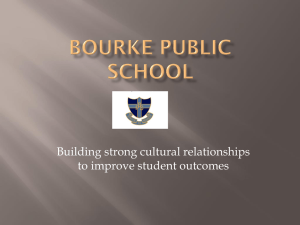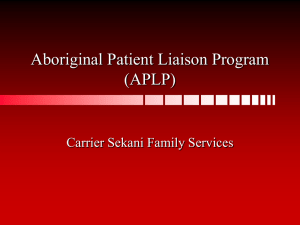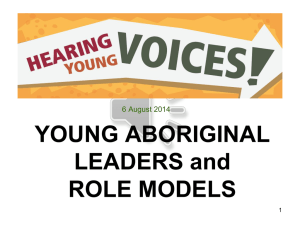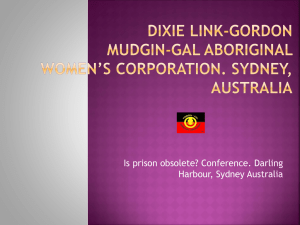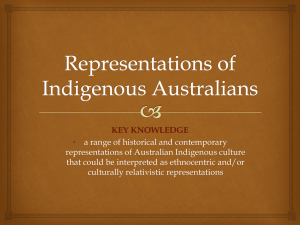In Indigenous Education - 8ways
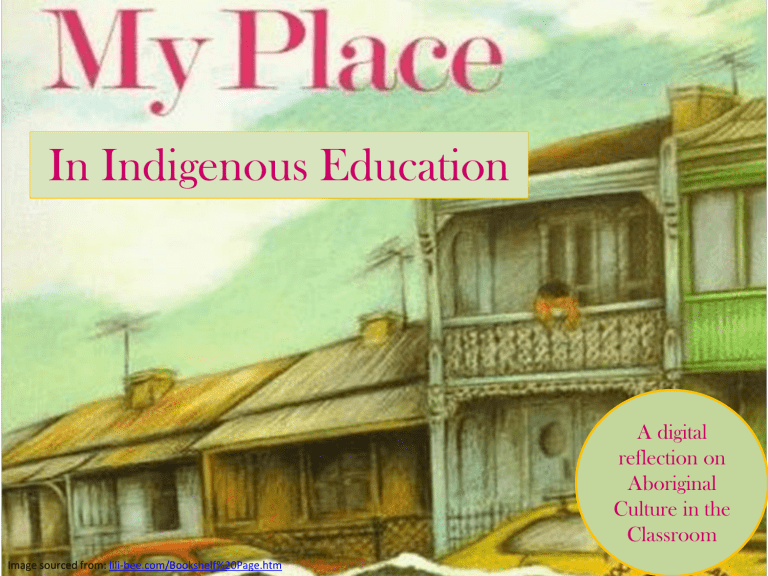
In Indigenous Education
A digital reflection on
Aboriginal
Culture in the
Classroom
Image sourced from: lili-bee.com/Bookshelf%20Page.htm
Where is my place in Indigenous education?
“Be grounded in your own cultural identity with integrity.”
(Cultural Interface Protocols for Engaging with Aboriginal Knowledge retrieved from: http://8ways.wikispaces.com/Interface+tehory )
To begin a reflection on my place in Indigenous education, I must first begin to reflect on my place in my own education.....
The void in a hegemonic history
Being schooled during the 1980s, by teachers who were schooled 10-20 years earlier, my formal education about
Aboriginal history must have been lacking much depth or diversity. Cavanagh (1999) methodically examines the contents of history books prior to the 1980s and concludes that there is an obvious lack of Aboriginal history.
What was I not taught?
Was I taught that European Civilisation brought with it technology, culture, decency, manners, disease, bloodshed and racism?
Retrieved from: http://history.howstuffworks.com/australia-and-new-zealand-history/aborigine2.htm
Retrieved from: www.sl.nsw.gov.au/.../firstfleet.html
Was I taught that
Aboriginal women and children were killed simply for being, or was I taught that revenge was discipline to the hard working settlers who made this land what it is today?
When I was taught that 26 th January is celebrated as Australia
Day, what type of Australia was being celebrated?
Retrieved from: http://indigenousrights.net.au/document.asp?iID=867
Was I taught that the same country who were world leaders in giving women the vote did not extend this liberty to
Aboriginal citizens until
1967 (seven years before I was born)?
Retrieved from: http://www.abc.net.au/news/stories/2009/09/09/2681032.htm
Was I ever taught of the battles that were proudly won on our own soil without the shedding of blood?
Retrieved from: http://keithlyons.wordpress.com/2009/03/28/everywhen/
When learning about democracy, was I ever taught how I, as a citizen, could make a difference?
Retrieved from: http://www.atsis.uq.edu.au/birranews/archive/26.html
When being taught morals, was I taught that stealing is always wrong or is it sometimes okay?
Retrieved from: http://questgarden.com/03/16/6/050930043803/task.htm/
“Aboriginal history is Australia’s history”
Singleton (2006 p28)
Australia’s history, our history, has typically been taught as an ethnocentric history where the dominant culture of winners has been responsible for documenting, and disseminating the history to perpetuate the myth that theirs is the voice of truth (Cavanagah, 1999; Iseke-Barnes, 2005; Maynard, 2007;
Mooney & Craven, 2007 and Wilson-Miller 2003).
The fundamental importance of teaching a balanced and comprehensive shared Australian history can not be overstated. The most important reason for this is that understanding our past helps us analyse our present which subsequently helps us shape the future (Wilson-Miller, 2003).
“Since 1788 ours is a shared history”
Cavanagh (1999 p157)
“ Bring your highest self to the knowledge and settle your fears and issues”
(Cultural Interface Protocols for Engaging with Aboriginal Knowledge retrieved from: http://8ways.wikispaces.com/Interface+tehory )
I have been made aware of the notable inequity of history traditionally taught in schools (Craven, 1999) and have reflected upon the impact this has had on
Australian society over time. The void in our national history has distorted our national identity.
After much thought and personal questioning I am becoming more comfortable with my place in a less than perfect education system. I have been grappling with the issue of Aboriginal and Anglo difference but am now focusing my efforts on identifying the similarities. The differences are to be valued and celebrated, but it is in the similarities that I see the way forward to genuine cross cultural teaching within the classroom.
Finding the common ground
The 8 Aboriginal Ways of Learning ( www.8ways.wikispaces.com
) provides an innovative way to apply common ground knowledge in the classroom. Teachers are able to use this framework to teach core curriculum subjects using
Aboriginal perspectives and learning techniques.
8 Aboriginal Ways of Learning http://8ways.wikispaces.com
On a personal level, the introduction to the 8 Aboriginal Ways of Learning was revolutionary for my pedagogical thinking. So many of these explicit techniques have been crucial to my own learning and are teaching methods I naturally employ.
In the classroom
The Aboriginal culture is often described using past tense . Whist the traditions and historical aspects of the culture can be referred to in this way, teachers must ensure that students understand that the Aboriginal culture is a contemporary living culture, not an ‘exotic’ way of life dead in the past (Phillips &
Lampert, 2005).
+
Schools contribute to our identity, our connection with other individuals and to Australian society in general (Phillips &
Lampert, 2005). Conceptions and experiences which shape our learning early in life affect our perception throughout our later lives also. These intuitive understandings are very difficult to change (Leonard, 2002).
Aboriginal students need to feel comfortable in their classrooms.
“….The ability to be comfortable in schooling and home cultural contexts, through the affirmation of Indigenous identity in schools, is crucial if one desires to participate in
the competitive economic climate we have today” (Duncan as cited in Phillips and
Lampert, 2005 p135).
Relationships
“If we are serious about addressing the needs of Aboriginal students, then we must look at our own practices in the classroom…”
(Harrison, 2008)
Harrison (2008) suggests that Indigenous children are more likely to work for the teacher if they like them. Whether or not this statement is particularly true for
Indigenous students, I don’t pretend to know, but I believe it to be true for students regardless of cultural background. If the relationship with the teacher is positive, the classroom environment will be more encouraging and thus more enjoyable.
My role as the class teacher doesn’t stop at the school gate. As a teacher of
Indigenous students I must build and foster respectful and mutual relationships with the Aboriginal community and/or their representatives.
The interesting thing about this, that I would like to do that for all my students….
After all, relationships are the ‘stuff’ of life!
References
8 Aboriginal Ways of Learning. (2009). Retrieved May 17 2010, from http://8ways.wikispaces.com
Cavanagh, P. (1999). Australian History: A new understanding. In R. G. Craven (Ed.), Teaching Aboriginal Studies. Crows Nest, NSW: Allen &
Unwin.
Craven, R. G. (Ed.). (1999). Teaching Aboriginal Studies. Crows Nest, NSW: Allen & Unwin.
Harrison, N. (2008). Teaching and learning in Indigenous education. South Melbourne, Vic: Oxford University Press.
Iseke-Barnes, J. (2005). Misrepresentations of indigenous history and science : public broadcasting, the internet, and education. Discourse,
26(2), 149-165.
Maynard, J. (2007). Circles in the sand : an Indigenous framework of historical practice. Australian Journal of Indigenous Education, 36(2007), pplement117-120.
Mooney, J., Craven, R. G., Self-concept, E., & Learning Facilitation Research Centre. International, C. (2007). Teaching Aboriginal studies :
improving professional practice in NSW schools. Paper presented at the Proceedings of the 4th International Biennial SELF research conference : self-concept, motivation, social and personal identity for the 21st Century. from http://web.archive.org/web/*/http://self.uws.edu.au/Conferences/2006/Mooney1.pdf
http://www.self.ox.ac.uk/Conferences/2006/Mooney1.pdf
Phillips, J., & Lampert, J. (2005). Introductory Indigenous Studies in Education. Frenches Forest, NSW: Person Education Australia.
Wheatley, N. & Rawlins, D. (1987). My Place: The story from now to then. Blackburn, Vic: Collins Dove.
Wilson-Miller, J., Australian Association for Research in Education, C., New Zealand Association for Research in Education, C., & Conference,
N. A. (2003). Re-thinking Aboriginal history : self-concept for a nation. from http://www.aare.edu.au/03pap/wil03788.pdf




